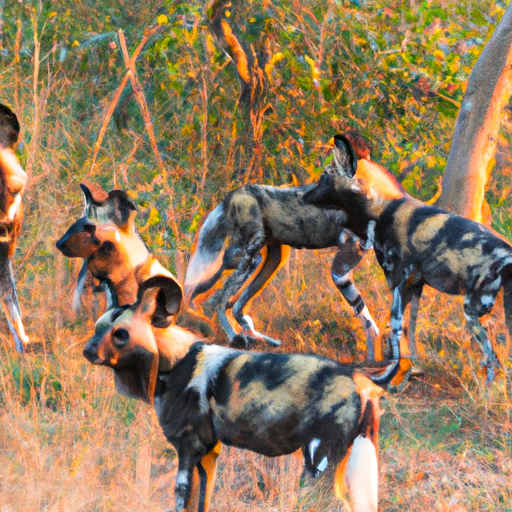Delve into the world of African wild dogs, one of Africa’s most captivating yet misunderstood creatures. Known for their distinctive coat patterns and cooperative hunting strategies, these canine species are truly a spectacle of the wild.
- African wild dogs are unique canines native to sub-Saharan Africa.
- They are known for their distinct coat patterns and social hunting strategies.
- Despite their fascinating traits, they are endangered due to various threats.
Table of Contents
- Introduction to African Wild Dogs
- Physical Characteristics
- Social Behavior and Hunting Strategies
- Reproduction and Lifespan
- Conservation Status and Threats
- Frequently Asked Questions
Introduction to African Wild Dogs
African wild dogs (Lycaon pictus), also known as African painted dogs or Cape hunting dogs, are canines native to sub-Saharan Africa. They’re not domesticated dogs gone wild, nor are they closely related to the wolves from which our domestic dogs descended. They are a separate, unique lineage of canines in their own right. You can learn more about their taxonomy here.
They are known for their distinctive coat patterns that feature patches of red, black, brown, white, and yellow fur. Each individual has a unique pattern, much like a human fingerprint.
Physical Characteristics
African wild dogs are medium-sized canines, with males slightly larger than females. They stand about 30 inches tall at the shoulder and can weigh between 40 to 70 pounds.
As an evolutionary adaptation to their long-distance running lifestyle, African wild dogs have a lean body and long, powerful limbs. Unlike most other canines, they have only four toes on each foot instead of five. Their large, rounded ears provide excellent hearing, an important attribute for these social and cooperative hunters.
Social Behavior and Hunting Strategies
African wild dogs live in packs, usually consisting of 6 to 20 members, though some packs can number over 40. They exhibit a strong sense of social structure, with an alpha male and female leading the pack. You can explore more about their social dynamics at One Top Dog.
One of the most fascinating aspects of African wild dogs is their cooperative hunting strategies. They work together to chase and exhaust their prey, displaying remarkable endurance and coordination. Their favorite prey includes antelopes, rodents, and birds. Their success rate in hunting is much higher than that of other large predators, thanks to their teamwork.
Reproduction and Lifespan
The alpha pair in a pack are typically the only ones to breed, and they can have a litter of up to 20 pups, which is the largest litter size among canines. All members of the pack help to take care of the young.
African wild dogs have a lifespan of about 10-12 years in the wild. More information about their reproduction and lifespan can be found here.
Conservation Status and Threats
Unfortunately, these beautiful and intriguing creatures are endangered. With only around 6,600 left in the wild, African wild dogs face several threats, including habitat loss, conflict with humans, disease, and competition with larger predators. Conservation efforts are underway to safeguard these dogs and their habitats. For more on this, see One Top Dog.
Frequently Asked Questions
-
Are African wild dogs related to domestic dogs?
No, African wild dogs are not closely related to domestic dogs. They are a separate lineage of canines. -
What do African wild dogs eat?
They primarily eat antelopes, but their diet can also include rodents, birds, and other small mammals. -
Why are African wild dogs endangered?
They face several threats, including habitat loss, conflict with humans, disease, and competition with larger predators.
Unraveling the world of the African wild dog allows us a glimpse into the intricate tapestry of life that exists in the African savannahs. By understanding and appreciating these animals, we can better advocate for their conservation, ensuring that future generations will also marvel at the sight of these painted predators.
For more information, you may visit the African Wildlife Foundation.



